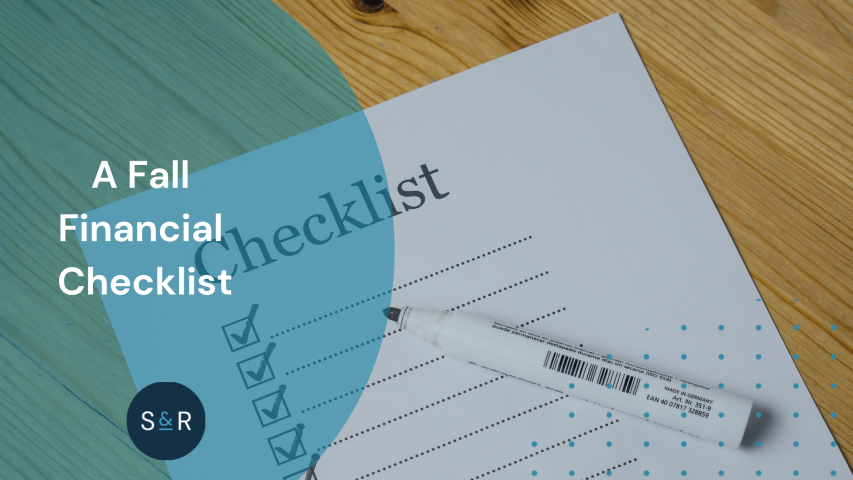A Fall Financial Checklist

3 Ways To Improve Your Finances for Self-Improvement Month
August 8, 2022
A Quick Guide to Estate Planning for Those With High Net Worth
October 20, 2022For many, autumn is the best time of year. The return of cool breezes, comforting foods, and pumpkins can be invigorating. It’s also a bookmark of sorts, especially for your finances—a perfect time to take stock of your spending after the summer’s over to see what lies ahead. These tips can help you make simple, sensible choices and take action to make the most of your money, from your food choices to your financial options to protecting your most valuable assets.
Bask in the Bounty
Autumn is all about fresh food, and you can get more bang for your buck with these tips.
Fall Fruits & Veggies:
This one’s all about supply and demand: you can usually get good prices on in-season fruits and veggies because they’re so plentiful. So stock up on autumn produce like apples, beets, pomegranates, squashes, and sweet potatoes, to name a few. They’ll be bursting with flavor and health benefits—especially at the local farmers market—without busting your budget.
Store Up Soup:
Speaking of fresh vegetables, they go really well in soup, another fall favorite—making it easier for you to maximize the produce you buy. A bonus for your bottom line: soup also freezes quite well. It can last up to three months frozen, so you can make one large pot of it and feed your family for weeks.
Focus on Financials
It’s been said that planning is bringing the future into the present so you can do something about it now, and that’s especially true when it comes to your end-of-year finances.
Work Benefits:
Company benefits often begin on January 1, so pay close attention to your company’s open enrollment period to determine the best insurance option for you and your family. Consider benefits like a flexible savings account (FSA), a health savings account (HSA), and a 401(k) (especially if there’s company matching) to determine what would best suit your family. Two important things to keep in mind: just because your benefit choices worked for you this year, it doesn’t mean they will next year, and for an existing FSA, make sure to use your money if there’s an end-of-year deadline! Finally, any company-sponsored discounts (such as a weight-loss program or gym membership) need to be submitted by the end of the year, so make sure to submit the paperwork to cash in.
Education:
If you have kids in college, look ahead to the spring semester. Granted, you may think “They just went back to school,” but now’s the time to focus on financial education planning. Keep an eye out for federal financial aid (FAFSA) application deadlines (which usually open in early fall). Spring tuition for many colleges can be due as early as November and as late as January, so mark it on your calendar and plan accordingly—especially with holiday bills also on the horizon—to avoid getting docked with late fees.
Investments:
Things change all the time in the finance world, especially taxes and laws, and these tend to go into effect in the new year. If you’re looking ahead with your other investments, such as your stock portfolio or loans, be well educated about your options and about what’s happening—and expected to happen—going forward. The best course of action? Touch base with your financial advisor, who can steer you on the path that’s right for you.
Holiday Shopping:
Many times, I’ve paid the price (literally and figuratively) for waiting until December to take care of my holiday shopping—when you’re desperate, stock is depleted, and the calendar is dwindling down, you’ll tend to pay full price. But if you’re smart about it, you can plan ahead and enjoy the holiday rush.
During the next several weeks between now and Black Friday be intentional as you prepare for what you want to buy—and what you want to pay for it. Scour the internet, and keep a spreadsheet of prices; that way, you’ll get a sense of what you can expect to spend and what’s a good deal. Also, be sure to set aside a little money out of every paycheck for the holidays—or do what I do: know your calendar. If you get paid biweekly, two months out of the year have an extra payday; October is one such month this year. See if you can dedicate part or all of your extra check to your holiday shopping, which will really help when the January credit card bills arrive.
Don’t Wait for Winter
Take advantage of the lovely autumn weather to cut down your bills—and prevent costly ones.
Home:
Fall is a great time to get your home ready inside and out for winter, which can offer big cost savings. Cleaning out your gutters in late autumn, when all the leaves have fallen, can help you avoid drainage trouble in winter, when it might also be difficult to remedy the situation. If your driveway or sidewalk needs repair, do it now before rain and ice seep into the cracks and holes, potentially causing costly underlying damage. And speaking of ice, if you live in a cooler climate, make sure that you remove outdoor hoses, turn off your water supply to outdoor spigots, and drain the spigots; otherwise, when the nighttime temperatures creep toward freezing later in the season, you may find yourself in a world of financial hurt when your pipes freeze.
Inside, you can cut down on future bills by ensuring your home is warm during the coming months. Have your furnace (and fireplace, if you have one) serviced and change its filter so it’s at peak capacity, and check your windows and doors for drafts and cracks, sealing where needed.
Car:
Much like you can with your home, taking necessary steps to winterize your car now can save you financial headaches down the (icy) road. Check your antifreeze level and temperature, tread life and balance of your tires (which should also be rotated), and the status of your wipers and windshield fluid. Have your heater and defrosters checked to make sure they are functioning well, and make sure you have an emergency kit.
LPL Tracking #1-05175159





